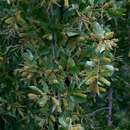en
names in breadcrumbs


Combretum imberbe (also known as leadwood or mhoba-hoba, Afrikaans: hardekool, Sotho: mohwelere-tšhipi, Tsonga: motswiri/mondzo, Zulu: impondondlovu) is a characteristic and often impressive bushwillow species of the southern Afrotropics. The medium to large tree[1] has a sparse, semi-deciduous canopy of grey-green leaves. The twigs and leaves are hairless as the name imberbe suggests. Its heartwood is dark brown, close-grained, and very hard and heavy, as suggested by its vernacular name.[2] The durable heartwood is much sought after in the woodcarving industry. The Hereros and Ovambos of Namibia attach special cultural and religious significance to the tree,[2] as to them it is the great ancestor of all animals and people, which must be passed with respect.
It is native to the mesic savannas of Africa south of the equator, from KwaZulu-Natal province, South Africa, in the south to Tanzania in the north. It is a native tree in South Africa, eSwatini, Botswana, Namibia, Zimbabwe, Mozambique, Angola, Zambia and Tanzania. It is a protected tree in South Africa.[3]
The largest bushwillow species of southern Africa[2] has a distinct habit and features. It has a spreading, rather sparse, roundish to slightly umbrella-shaped crown. The smallish, grey-green leaves and small, yellowish-green samaras are carried on spiny, attenuate branchlets.[4]
It typically grows 7 metres (23 ft) to 15 metres (49 ft) tall,[2] but may reach 20 metres (66 ft). In maturity the single, solid bole may be up 1.5 metres (4.9 ft) in diameter. The distinctive bark is pale to dark grey in colour, deeply fissured lengthwise.[1] Irregular horizontal cracks infuse the bark a fairly regular, coarse-grained appearance.
Radiocarbon dating, done in South Africa, has established that a leadwood tree can live up to 1070 ± 40 years.[5] A tree can remain standing for many years after it has died.
{{cite web}}: CS1 maint: archived copy as title (link) Combretum imberbe (also known as leadwood or mhoba-hoba, Afrikaans: hardekool, Sotho: mohwelere-tšhipi, Tsonga: motswiri/mondzo, Zulu: impondondlovu) is a characteristic and often impressive bushwillow species of the southern Afrotropics. The medium to large tree has a sparse, semi-deciduous canopy of grey-green leaves. The twigs and leaves are hairless as the name imberbe suggests. Its heartwood is dark brown, close-grained, and very hard and heavy, as suggested by its vernacular name. The durable heartwood is much sought after in the woodcarving industry. The Hereros and Ovambos of Namibia attach special cultural and religious significance to the tree, as to them it is the great ancestor of all animals and people, which must be passed with respect.